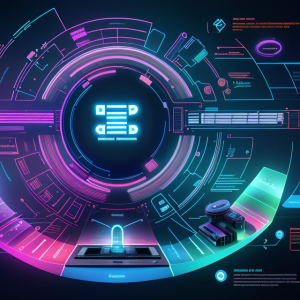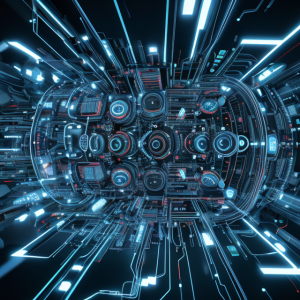Deep learning is a subfield of machine learning that is concerned with the development of algorithms that can learn and make predictions by modeling complex patterns in large datasets. The concept of deep learning has been around for several decades, but it was not until the early 2010s that it really took off. This period saw a surge in research and development in deep learning, driven by the availability of large datasets, the advancement of hardware, and the need for more accurate and efficient models. The rapid progress in deep learning has since had a profound impact on a wide range of fields, from healthcare and finance to transportation and entertainment. In this article, we will explore the key factors that contributed to the rise of deep learning and its transformative effects on the world.
Deep learning, a subfield of machine learning, took off in the mid-2000s, thanks to advances in computational power, access to large datasets, and the development of specialized deep learning algorithms. Key milestones include the introduction of the AlexNet architecture in 2012, which won the ImageNet competition and demonstrated the potential of deep neural networks, and the release of the Caffe and TensorFlow frameworks in 2014, which made it easier for researchers and developers to build and train deep learning models. The widespread adoption of deep learning has since led to significant breakthroughs in various domains, including computer vision, natural language processing, and speech recognition.
The Evolution of Deep Learning
Early Developments in Neural Networks
The Birth of Artificial Neural Networks
The concept of artificial neural networks dates back to the 1940s when scientists, inspired by the structure and function of biological neurons, began to develop computational models that could mimic the human brain's ability to learn and adapt. Researchers such as Warren McCulloch and Walter Pitts, along with Norbert Wiener, laid the foundation for this nascent field by proposing the first simple models consisting of a few interconnected neurons. These early models aimed to explore the fundamental principles of learning and pattern recognition in artificial systems.
The Limited Capabilities of Early Neural Networks
However, the early neural networks faced significant limitations in terms of their capacity to store and process information. These limitations were mainly due to the lack of computational power and the limited availability of data. Researchers struggled to train these networks with enough data to overcome the so-called "vanishing gradient" problem, which hindered the networks' ability to learn and generalize from the data. As a result, the early neural networks could only perform simple tasks such as linear classification and pattern recognition, which were far from the complex problems that human brains can solve effortlessly.
The Emergence of Deep Learning as an Extension of Neural Networks
Despite these limitations, researchers continued to refine and improve the underlying algorithms and architectures of neural networks. In the 1980s, a new class of neural networks called "backpropagation" was introduced, which enabled more efficient training of deep networks. This breakthrough, combined with the increasing availability of computational power and the growth of large datasets, paved the way for the emergence of deep learning as a powerful tool for solving complex problems. By stacking multiple layers of neurons, deep learning algorithms could learn increasingly abstract and sophisticated representations of data, allowing them to tackle tasks such as image recognition, speech recognition, and natural language processing with unprecedented accuracy. This marked a significant turning point in the evolution of artificial neural networks and set the stage for the rapid advancements in deep learning that we see today.
Milestones in Deep Learning Research
- The introduction of backpropagation algorithm
- The backpropagation algorithm is a crucial component of deep learning that enables the training of neural networks with many layers. It was first introduced by David Rumelhart, Geoffrey Hinton, and Ronald Williams in 1986. The backpropagation algorithm uses the gradient of the loss function with respect to the model's parameters to update the weights of the network, allowing it to learn from data.
- The breakthrough with convolutional neural networks (CNNs)
- Convolutional neural networks (CNNs) are a type of deep learning model that are particularly well-suited for image recognition tasks. They were first proposed by Yann LeCun, David Bottou, Yoshua Bengio, and Patrick Haffner in 1998. CNNs use convolutional layers to extract features from images, which are then processed by pooling and fully connected layers. The breakthrough with CNNs came in 2012 with the introduction of AlexNet, which won the ImageNet competition and demonstrated the power of deep learning for image recognition tasks.
- The impact of recurrent neural networks (RNNs)
- Recurrent neural networks (RNNs) are a type of deep learning model that are particularly well-suited for sequence-to-sequence tasks, such as language translation or speech recognition. They were first proposed by Sepp Hochreiter and Jürgen Schmidhuber in 1991. RNNs use hidden states to process sequences of data, allowing them to capture long-term dependencies and context. The impact of RNNs came in 2015 with the introduction of the Long Short-Term Memory (LSTM) network, which improved the performance of RNNs on sequence-to-sequence tasks.
- The rise of unsupervised learning with restricted Boltzmann machines (RBMs)
- Restricted Boltzmann machines (RBMs) are a type of deep learning model that are particularly well-suited for unsupervised learning tasks, such as feature learning and generative modeling. They were first proposed by Geoffrey Hinton and Terrence Sejnowski in 2009. RBMs use a two-layer neural network to learn a probabilistic representation of the input data, which can be used for tasks such as image generation and denoising. The rise of unsupervised learning with RBMs came in 2010 with the introduction of deep belief networks (DBNs), which are composed of multiple RBMs stacked together.
- The resurgence of deep learning with the AlexNet model
- The resurgence of deep learning came in 2012 with the introduction of the AlexNet model, which won the ImageNet competition and demonstrated the power of deep learning for image recognition tasks. The AlexNet model was designed by Alex Krizhevsky, Ilya Sutskever, and Geoffrey Eaton. It used a convolutional architecture and was trained using stochastic gradient descent with momentum. The success of the AlexNet model sparked a renewed interest in deep learning and led to the development of many new models and applications.
Factors Contributing to the Takeoff of Deep Learning
Availability of Big Data
The exponential growth of data in the digital age
In recent years, the world has witnessed an unprecedented explosion of data, thanks to the rapid advancement of technology and the proliferation of digital devices. This data deluge has created an environment that is ripe for deep learning, as it provides a wealth of information that can be used to train complex neural networks. The exponential growth of data has been driven by a variety of factors, including the widespread adoption of smartphones, the rise of social media, and the proliferation of internet-connected devices.
The importance of large datasets for training deep learning models
One of the key factors that has enabled deep learning to take off is the availability of large datasets that can be used to train neural networks. Deep learning models require vast amounts of data in order to learn and make accurate predictions, and the larger the dataset, the more accurate the model is likely to be. This is because deep learning models are capable of learning intricate patterns and relationships in data, and the more data they have to work with, the more likely they are to find these patterns and relationships. As a result, large datasets have become a critical resource for deep learning researchers, and many organizations have invested heavily in building and collecting large datasets.
The role of data augmentation techniques in enhancing training data
In addition to the availability of large datasets, the use of data augmentation techniques has also played a critical role in enabling deep learning to take off. Data augmentation involves using various techniques to generate new training data from existing data, which can help to increase the size and diversity of the dataset and improve the performance of the deep learning model. Some common data augmentation techniques include flipping, rotating, and cropping images, as well as adding noise to audio signals. By using these techniques, researchers can create more training data from existing data, which can help to improve the accuracy and generalizability of the deep learning model.
Advancements in Computing Power
The development of deep learning was significantly influenced by advancements in computing power. The ability to process large amounts of data and perform complex calculations at an accelerated pace played a crucial role in the rapid growth of deep learning techniques.
One key factor in this advancement was the increasing availability and power of hardware, specifically graphical processing units (GPUs). GPUs, which were initially designed for gaming, proved to be highly efficient in handling the massive parallel computations required for deep learning algorithms. This realization led to the widespread adoption of GPUs in deep learning research and development.
Additionally, the rise of cloud computing provided researchers and practitioners with accessible and scalable computing resources. Cloud computing platforms enabled users to rent computational power and storage, eliminating the need for expensive hardware investments and lowering the barriers to entry for those interested in deep learning. This democratization of computing resources allowed for a rapid increase in the number of deep learning projects and applications.
The combination of powerful GPUs and cloud computing services created a perfect environment for deep learning to flourish. This, in turn, led to significant breakthroughs in various domains, including computer vision, natural language processing, and speech recognition, among others. The symbiotic relationship between advancements in computing power and the development of deep learning techniques has been a crucial factor in the widespread adoption and success of deep learning in recent years.
Breakthroughs in Algorithmic Improvements
- The development of efficient optimization algorithms
- The role of gradient descent in the training of deep neural networks
- The introduction of more advanced optimization techniques such as Adam and Adagrad
- The significance of the learning rate schedule in achieving faster convergence
- The introduction of regularization techniques to prevent overfitting
- The use of L1 and L2 regularization to add a penalty for large weights
- The introduction of dropout regularization to prevent overfitting by randomly dropping out neurons during training
- The use of data augmentation to increase the size and diversity of training data
- The role of transfer learning in leveraging pre-trained models
- The ability to fine-tune pre-trained models on new tasks using a smaller amount of data
- The use of pre-trained models as a starting point for training on a new task, allowing for faster convergence and improved performance
- The significance of network architectures such as deep residual networks (ResNets)
- The introduction of ResNets, which allow for the training of much deeper networks by addressing the vanishing gradient problem
- The development of other network architectures such as U-Net and DenseNet, which have also contributed to the success of deep learning
Application Areas and Success Stories
Computer Vision
- Deep learning revolutionizing image classification and object detection
- Traditional computer vision techniques such as edge detection and Hough transforms have been replaced by deep learning methods like convolutional neural networks (CNNs) for image classification and object detection tasks.
- CNNs have shown significant improvements in accuracy and efficiency over traditional methods, especially in complex and large-scale datasets.
- For example, in the ImageNet dataset, CNNs achieved a top-1 accuracy of 74.8% in 2012, compared to the previous record of 72.4% by a traditional feature-based method in 2006.
- Advancements in facial recognition technology
- Facial recognition technology has seen a major boost with the use of deep learning methods.
- Deep learning-based methods have achieved state-of-the-art performance in various facial recognition tasks, such as face verification and face identification.
- For instance, the FaceNet model trained on a large-scale dataset of faces achieved a remarkable performance of 97.35% in face verification, which is considered to be a benchmark in the field.
- Deep learning for autonomous driving and robotics
- Deep learning has enabled significant advancements in autonomous driving and robotics.
- Convolutional neural networks are used for object detection and classification, while recurrent neural networks are used for predicting future positions and actions of objects.
- Deep learning-based approaches have outperformed traditional methods in various robotics tasks, such as grasping and manipulation, which are critical for autonomous driving and robotics.
- For example, the DeepMind team achieved a significant breakthrough in 2016 by developing a deep learning-based approach that was able to play the game of Go at a world-class level, which was considered to be a major milestone in the field of AI and robotics.
Natural Language Processing
Deep learning has revolutionized the field of natural language processing (NLP) by enabling computers to understand, interpret, and generate human language. The impact of deep learning on NLP has been significant, with applications ranging from language translation to sentiment analysis and text generation.
The impact of deep learning on language translation
Deep learning has had a profound impact on language translation, enabling machines to translate text with higher accuracy and fluency than ever before. Traditional machine translation techniques relied on rule-based systems and statistical models, which often resulted in inaccurate translations. However, with the advent of deep learning, neural machine translation (NMT) has become the state-of-the-art technique for language translation. NMT models use deep neural networks to learn the relationships between words and phrases in two languages, allowing for more accurate and natural-sounding translations. As a result, deep learning has enabled computers to translate text in real-time, making it possible to communicate across language barriers with ease.
Sentiment analysis and text generation with deep learning
Deep learning has also been applied to sentiment analysis, which involves determining the sentiment expressed in a piece of text. Sentiment analysis is used in a variety of applications, such as social media monitoring, customer feedback analysis, and market research. Deep learning techniques, such as recurrent neural networks (RNNs) and convolutional neural networks (CNNs), have been used to develop sentiment analysis models that can accurately classify text as positive, negative, or neutral.
In addition, deep learning has enabled computers to generate text that is coherent and relevant to a given prompt. Text generation with deep learning involves training a neural network to generate text based on a given input. This has applications in areas such as chatbots and virtual assistants, where machines need to generate responses to user queries. Deep learning techniques, such as generative adversarial networks (GANs) and variational autoencoders (VAEs), have been used to develop text generation models that can generate coherent and relevant text.
Chatbots and virtual assistants powered by deep learning techniques
Deep learning has also enabled the development of chatbots and virtual assistants that can interact with humans in a natural way. Chatbots are computer programs that simulate conversation with human users, while virtual assistants are software applications that assist users with tasks, such as scheduling appointments or sending messages. Deep learning techniques, such as RNNs and transformers, have been used to develop chatbots and virtual assistants that can understand natural language input and generate appropriate responses. This has enabled machines to perform tasks that were previously thought to be the exclusive domain of humans, such as answering questions and providing advice.
Overall, deep learning has had a significant impact on natural language processing, enabling machines to understand, interpret, and generate human language with greater accuracy and fluency than ever before. As deep learning continues to evolve, it is likely that we will see even more innovative applications of NLP in the years to come.
Healthcare and Biomedicine
Deep learning has made significant strides in the field of healthcare and biomedicine, transforming the way medical professionals diagnose and treat diseases. The following are some of the key areas where deep learning has made a significant impact:
Deep learning in medical imaging analysis
Medical imaging, such as X-rays, CT scans, and MRI, produce large volumes of complex data that can be challenging to analyze. Deep learning algorithms have proven to be effective in analyzing these images, enabling faster and more accurate diagnoses. For example, deep learning algorithms have been used to detect cancerous tumors in mammograms, identify abnormalities in retinal images, and diagnose diseases such as Alzheimer's and Parkinson's.
Predictive modeling for disease diagnosis and treatment
Deep learning has also been used to develop predictive models for disease diagnosis and treatment. These models use large amounts of data to identify patterns and correlations that can help predict the likelihood of a particular disease or the effectiveness of a particular treatment. For example, deep learning algorithms have been used to predict the likelihood of a patient developing type 2 diabetes based on their genetic and lifestyle factors.
Drug discovery and personalized medicine with deep learning
Deep learning has the potential to revolutionize drug discovery by enabling researchers to design more effective drugs and identifying new drug targets. By analyzing large datasets of molecular structures and biological activity, deep learning algorithms can predict the potential effectiveness of a drug and identify potential side effects. Additionally, deep learning can be used to develop personalized medicine, tailoring treatments to an individual's unique genetic makeup and medical history. For example, deep learning algorithms have been used to predict the effectiveness of immunotherapy for cancer patients based on their genetic profile.
Challenges and Future Directions
Interpretability and Explainability
Deep learning models have revolutionized the field of artificial intelligence, and have achieved state-of-the-art results in a wide range of applications. However, one of the major challenges with deep learning is its interpretability and explainability. The black box nature of deep learning models, which makes them difficult to understand and interpret, has been a major obstacle in their adoption in many domains.
The need for interpretable deep learning techniques has become increasingly important as these models are being used in critical applications such as healthcare, finance, and transportation. The inability to understand how a deep learning model is making a decision can lead to unintended consequences and ethical concerns. Therefore, there is a growing need for research in explainable AI to address this challenge.
Current research efforts in explainable AI focus on developing techniques to make deep learning models more interpretable and understandable. Some of the approaches being explored include:
- Attribution methods: These methods attempt to explain the decisions made by a deep learning model by attributing the contribution of each feature to the final prediction. This can be done using global or local methods.
- Visualization techniques: These techniques provide visual representations of the deep learning model's internal computations, such as decision boundaries or feature maps, to help humans understand how the model is making decisions.
- Rule extraction: This approach involves extracting rules or decision trees from the deep learning model's internal computations to provide a more interpretable representation of the model's decision-making process.
Overall, interpretability and explainability are critical challenges in deep learning that need to be addressed to ensure the safe and ethical use of these models in critical applications.
Ethical Considerations
Potential biases in deep learning algorithms
Deep learning algorithms are only as good as the data they are trained on. This means that if the data used to train these algorithms is biased, the resulting models will also be biased. For example, if a deep learning model is trained on a dataset that is predominantly made up of images of people with a certain skin color, it will be better at recognizing that skin color and may perform poorly on other skin colors. This can lead to issues with fairness and accuracy in the application of these models.
Ensuring fairness and accountability in deep learning applications
As deep learning models become more widely used, it is important to ensure that they are being used fairly and that their decisions are accountable. This means taking steps to mitigate the potential biases that can be introduced into these models during training. It also means ensuring that the decisions made by these models can be explained and justified. This can be particularly important in high-stakes applications such as criminal justice or healthcare.
The importance of ethical guidelines in the development of deep learning systems
As deep learning continues to advance and become more widely used, it is important to establish ethical guidelines for the development and deployment of these systems. This includes considering the potential impacts of these systems on society and ensuring that they are used in a way that is fair, transparent, and accountable. It also means taking steps to mitigate the potential biases that can be introduced into these models during training and ensuring that the decisions made by these models can be explained and justified. By establishing these guidelines, we can help ensure that deep learning is used in a way that benefits society as a whole.
Continual Learning and Lifelong Adaptation
The Challenge of Retaining Knowledge in Deep Learning Models
One of the major challenges in deep learning is the inability of models to retain knowledge acquired during training. This issue is particularly pronounced in the context of continual learning, where models are expected to learn from and adapt to new data streams over time. The phenomenon of catastrophic forgetting in neural networks poses a significant obstacle to the development of lifelong learning agents.
Progress in Lifelong Learning Techniques for Deep Neural Networks
To address the challenge of catastrophic forgetting, researchers have developed various techniques to facilitate lifelong learning in deep neural networks. These techniques include:
- Incremental learning: This approach involves adding new layers to the network as new data becomes available, allowing the model to learn from each data stream without interfering with its existing knowledge.
- Elastic weight consolidation (EWC): EWC is a regularization technique that encourages the network to retain important knowledge from previous tasks while adapting to new ones. It does this by adding a penalty term to the loss function that measures the change in important model parameters.
- Sparse learning: This approach involves sparsifying the model's weights, leading to more efficient use of memory and computational resources. Sparse learning can help prevent overfitting and enable better continual learning performance.
- Meta-learning: Meta-learning focuses on training a model to learn how to learn. By training a meta-learner on a variety of tasks, it can develop a general strategy for quickly adapting to new situations, reducing the need for task-specific fine-tuning.
The Potential for Continual Learning to Enable More Flexible and Adaptive AI Systems
Continual learning and lifelong adaptation have the potential to enable more flexible and adaptive AI systems that can learn and grow over time. As deep learning models become more adept at retaining knowledge across multiple tasks and data streams, they will be better equipped to handle the complex and dynamic environments that characterize many real-world applications. This could lead to significant advances in areas such as robotics, autonomous vehicles, and healthcare, where the ability to continually learn and adapt is critical for success.
FAQs
1. When did deep learning take off?
Deep learning has its roots in artificial neural networks, which were first introduced in the 1940s. However, it wasn't until the 2000s that deep learning really took off. This surge in popularity was largely due to advances in computational power, the availability of large datasets, and the need for more accurate and efficient machine learning algorithms. The breakthrough moment for deep learning was in 2012, when a deep neural network was able to recognize images with high accuracy, surpassing previous state-of-the-art methods. Since then, deep learning has continued to revolutionize various fields, including computer vision, natural language processing, and speech recognition.
2. What was the key factor that led to the rise of deep learning?
The key factor that led to the rise of deep learning was the availability of large amounts of data and the increase in computational power. As more data became available, it became clear that traditional machine learning algorithms were not able to effectively utilize this data. Deep learning algorithms, on the other hand, are able to automatically learn features from data, making them well-suited for large datasets. Additionally, the increased computational power allowed for deeper and more complex neural networks to be trained in a reasonable amount of time.
3. What are some notable achievements of deep learning?
Deep learning has achieved many notable milestones in recent years. In computer vision, deep learning has led to state-of-the-art performance in tasks such as image classification, object detection, and semantic segmentation. In natural language processing, deep learning has enabled the development of sophisticated language models and advanced chatbots. In speech recognition, deep learning has dramatically improved the accuracy of speech-to-text systems. In healthcare, deep learning has been used to develop better diagnostic tools and to predict patient outcomes. Overall, deep learning has had a significant impact on many fields and has opened up new possibilities for machine learning.





